Tractors in Modern Agriculture: Benefits and Challenges
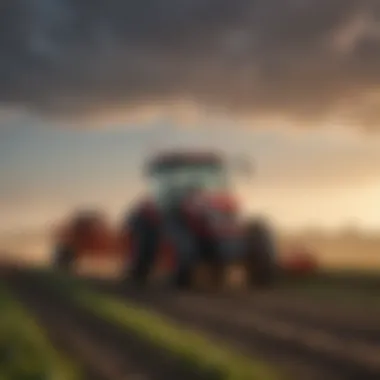
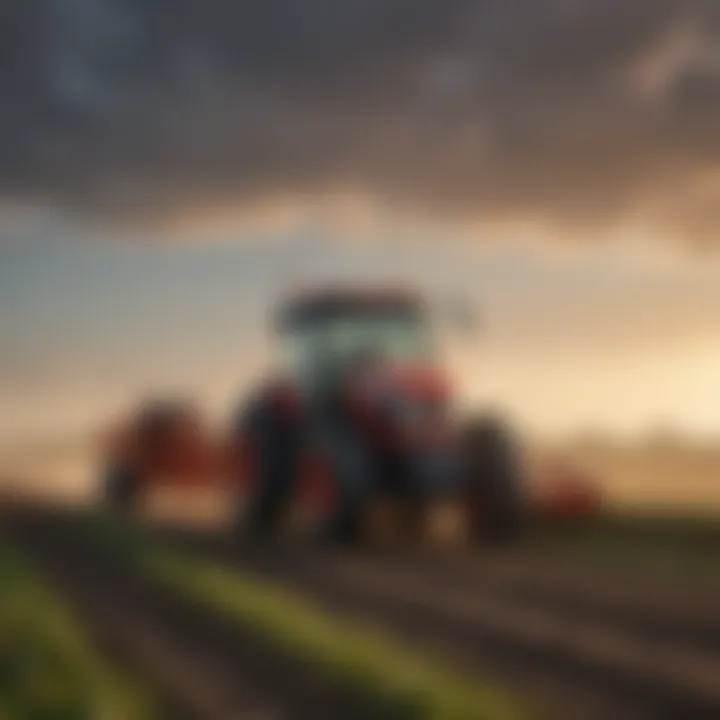
Intro
Tractors have become an indispensable part of the agricultural landscape. These powerful machines support farmers in numerous ways, making tasks more efficient and less labor-intensive. Over the years, technology has pushed the boundaries of what tractors can accomplish, evolving from rudimentary devices pulled by horses to sophisticated computer-driven systems. Tractors today not only plow fields but also integrate smart technology that optimizes their operations.
In this exploration, we specifically look at how tractors enhance farming practices and the challenges they present. While they undeniably streamline processes, questions about sustainability and operational difficulties persist. What future developments can we expect? This article aims to offer an informed perspective on the role of tractors in shaping modern agriculture.
Overview of the Topic
Definition and Importance
At its core, a tractor is designed to provide high-power and low-speed functions to perform tasks like tilling, planting, and harvesting. Tractors boost productivity, allowing farmers to manage larger plots of land effectively. Their importance shines through when we consider the sheer volume of food production needed to sustain the growing global population.
- Versatility: Tractors can be equipped with various attachments, making them suitable for tasks ranging from spraying pesticides to hauling supplies.
- Efficiency: Modern tractors, with their advanced technology, can perform tasks that previously took much longer, reducing labor costs and time.
Current Trends
Farming methods are continually changing, and the current trends show an increasing reliance on technology:
- GPS Technology: Precision farming uses GPS systems for mapping fields, determining the best cropping patterns, and monitoring crop health.
- Automation: Autonomous tractors are making headway, minimizing the need for direct human intervention.
- Sustainability: Electric and hybrid tractors are emerging as energy-efficient solutions, aiming to reduce carbon footprints in agriculture.
Key Techniques and Practices
Step-by-Step Guide
To comprehend the full impact of tractors on modern farming, let's examine key techniques:
- Choosing the Right Tractor: Farmers must consider the size of their land, the types of crops grown, and the specific tasks to be performed.
- Implementing Precision Technology: Integrating technology such as soil sensors and drones assists in making informed decisions about planting and irrigation.
- Regular Maintenance: Keeping tractors in good working condition involves scheduled maintenance to prevent breakdowns and ensure optimum performance.
- Smaller, versatile tractors work well for varied, smaller plots, while larger, more powerful models serve vast expanses.
Tools and Equipment Needed
The right tools can significantly enhance the functionality of a tractor:
- Plows: For tilling the soil, preparing it for planting.
- Seeders: For efficient planting of seeds in optimal conditions.
- Harvesters: To gather mature crops quickly and effectively.
Challenges and Solutions
Common Obstacles
Even with their many benefits, tractors pose certain challenges:
- Cost: High initial investment can be a barrier for many farmers, especially smallholders.
- Complexity: Recent advancements often mean that operators need specific training to handle the sophisticated technology.
- Environmental Impact: Gas-powered tractors contribute to greenhouse gas emissions, causing concerns among environmentally conscious farmers.
Innovative Solutions
Several creative solutions are taking shape to tackle these challenges:
- Financial Assistance Programs: Governments and organizations are providing funding options or subsidies to help farmers acquire modern tractors.
- Training Programs: Community colleges and agricultural organizations offer training classes focusing on operational efficiency and maintenance of modern tractors.
- Development of Eco-Friendly Machines: Manufacturers are focusing on producing electric tractors that not only reduce emissions but also lower operational costs in the long run.
"The future of tractors is not just about power but integrating technology and sustainability to make agriculture thrive."
Epilogue
The journey of tractors in agriculture is far from over. As they continue to integrate cutting-edge technology with a focus on sustainability, their role is set to expand. Understanding the advancements, challenges, and innovative solutions surrounding tractors is crucial for farmers looking to optimize their practices and meet the agricultural demands of tomorrow.
In a world striving for smarter farming solutions, tractors remain at the forefront, marrying tradition with innovation.
Foreword to Tractors in Agriculture
In today's agricultural landscape, tractors play a critical role, transforming the way farming is conducted. The introduction of tractors has not only enhanced agricultural productivity but has also paved the path for significant advancements in the sector. As we navigate through the intricacies of modern farming, understanding the role of tractors becomes paramount. Their ability to effectively carry out time-consuming and labor-intensive tasks has reshaped farming operations, making them more efficient and streamlined.
Historical Overview

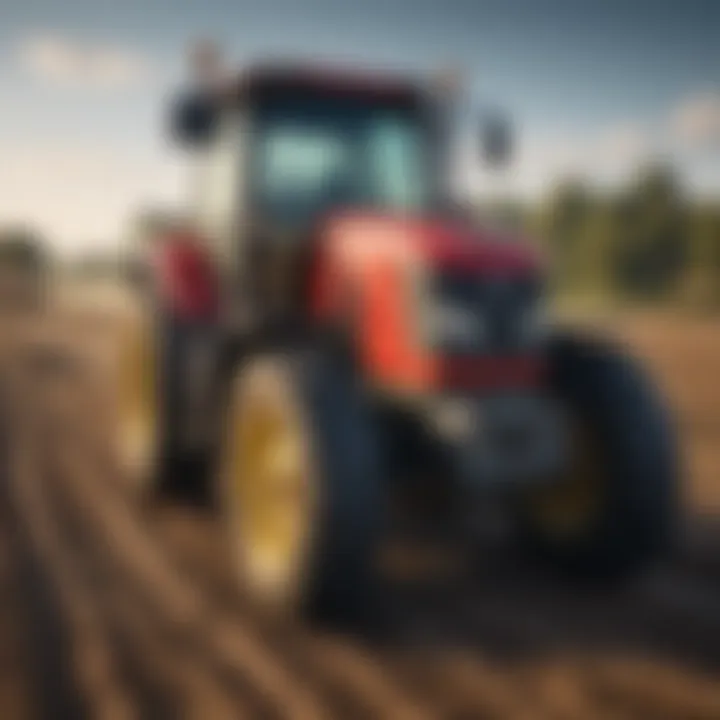
The journey of tractors in agriculture dates back to the early 20th century. Initially, farming relied heavily on animals and manual labor. Early tractors were introduced as a means to alleviate the burden of such labor. These machines were often crude and inefficient, yet they represented a leap forward. Farmers embraced these machines, and their design gradually evolved from simple steam-powered engines to gas and diesel models. The introduction of the Fordson tractor in 1917 marked a significant milestone, making tractors accessible to small-scale farmers. Over the decades, tractors have continued to innovate, leading us to today’s highly advanced machinery.
Modern Relevance
Fast forward to the present, tractors have become indispensable in modern agriculture. Not only do they boost crop yields, but they also minimize the time needed for various farming processes. The shift towards mechanization has given rise to specialized tractors designed for particular tasks. For instance, utility tractors are versatile, while row crop tractors are engineered for precision in planting and harvesting. Today’s tractors are equipped with cutting-edge technology such as GPS and automated systems, enhancing their effectiveness on the field. These advancements also allow farmers to gather vital data about their crops and soil, contributing to better management decisions.
"The ability to adapt and harness technology through tractors defines not just farming today but paves the way for future innovations in agriculture."
By understanding both the rich history and modern applications of tractors, we can better appreciate the intricacies of farming today. Their role in agriculture embodies a continuous evolution, reflecting changes in agricultural practices, societal needs, and technological advancements.
Types of Tractors Utilized in Agriculture
Understanding the different types of tractors used in today's farming operations is key to grasping how they bolster efficiency and productivity in agriculture. Each type serves distinct purposes and comes with its own set of advantages, which can significantly impact the farming process. As a farmer or agriculture enthusiast, knowing which tractor to use for specific tasks can lead to better outcomes and resource management. This section explores three main categories of tractors: utility tractors, row crop tractors, and garden tractors, while discussing their features, applications, and importance in the agricultural landscape.
Utility Tractors
Utility tractors are like the Swiss Army knives of the agricultural world. They are versatile machines suited for a variety of tasks, from plowing fields to hauling materials. With their reasonable horsepower, usually ranging from 40 to 100, they can take on both light and heavy jobs without breaking a sweat. Their design allows for compatibility with various implements such as plows, mowers, and loaders.
One of the major benefits of utility tractors is their adaptability. Farmers can easily switch out attachments based on the season or specific task at hand. For instance, during planting season, a farmer might use a seed drill attachment, and come harvest time, they could attach a loader for moving crops.
However, choosing a utility tractor comes with considerations. The size of the tractor should match the land it will work on, as a machine that is too large may compact the soil, while one that's too small might not effectively handle the chores it’s assigned. Thus, farmers must evaluate their farming practices carefully before making a purchase.
Row Crop Tractors
Row crop tractors are specially designed for crops arranged in rows, making them indispensable in modern farming, especially for those who grow corn, soybeans, or other similar plants. These tractors are typically narrower and taller than utility tractors which allows them to maneuver between rows with ease, thereby minimizing crop damage.
With a greater emphasis on efficiency, row crop tractors often come equipped with advanced technology that supports precision agriculture. Features like adjustable wheel widths allow farmers to configure their tractors according to the spacing of their crops, ensuring maximum yield potential. The horsepower in these tractors tends to be higher, which is essential for tasks such as tilling and planting in larger fields.
Economically, row crop tractors can increase a farm’s productivity. The ability to till, plant, and even fertilize without needing to drive over the crops reduces waste and promotes better growth. It’s not just about the horsepower but also about how effectively these machines can integrate with other farm technologies.
Garden Tractors
Garden tractors, on the other hand, serve a different niche altogether. These smaller machines are ideal for smaller plots or home gardens. They handle light-duty tasks like mowing lawns, tilling soil, and transporting small loads around the farmstead. The typical horsepower for garden tractors ranges from 10 to 30, making them approachable for homeowners or small-scale farmers.
What makes garden tractors particularly appealing is their ease of use. They often come with simple controls that don't require extensive training. Even hobby farmers or amateurs can effectively operate them. Furthermore, they can tackle tasks like landscaping or snow removal, proving their worth beyond just agricultural use.
Nevertheless, it’s important for users to consider the limitations of garden tractors. While they are efficient for smaller tasks, they lack the power and capabilities required for larger farming activities. As a result, they are best used in conjunction with larger tractors or for defined projects.
In summary, the variety of tractors available today allows for tailored approaches to farming, catering to different scales and types of agricultural practices. Understanding how utility, row crop, and garden tractors function can help farmers make informed decisions that can lead to improved productivity and sustainability in agriculture.
Tractor Technologies Shaping the Industry
In the realm of modern agriculture, the emergence of advanced tractor technologies has brought about significant changes, fundamentally reshaping farming practices. These technologies not only enhance efficiency but also offer farmers tools to make informed decisions that can lead to sustainable practices and improved outcomes. Understanding these innovations is key for anyone involved in the agricultural sector, as they directly impact productivity, resource management, and environmental stewardship.
Precision Agriculture
Precision agriculture is a critical concept in modern farming, utilizing advanced technologies to increase crop yields while minimizing waste and environmental impact. This approach involves the use of detailed data and tools to manage field variability in crops effectively.
GPS Guidance Systems
GPS Guidance Systems are a cornerstone of precision agriculture. They enable tractors to navigate fields with pinpoint accuracy, ensuring that every inch is covered efficiently. The standout feature of these systems is their ability to reduce overlapping passes while applying inputs such as fertilizers and pesticides.
- Key Characteristic: The real-time positioning and mapping capabilities allow for systematic coverage of wide fields.
- Benefits: This not only saves time but significantly cuts down on input costs, making GPS Guidance a favored choice among modern farmers.
- Unique Feature: Many systems can be integrated with autopilot capability which can further lessen the burden on the operator, showcasing the flexibility of this technology.
- Considerations: However, the initial investment can be hefty and, depending on the technology, ongoing subscription services may apply, which can deter smaller farming operations from adopting it.
Variable Rate Technology
Variable Rate Technology (VRT) complements GPS systems by enabling farmers to apply inputs at varying rates across their fields. This technology is particularly useful for optimizing the application of seeds, fertilizers, and pesticides based on specific field conditions.
- Key Characteristic: The ability to customize application rates based on soil health data or crop requirements is what sets VRT apart.
- Benefits: By applying the right amount of inputs where needed, farmers can enhance crop productivity while reducing waste.
- Unique Feature: Integration with other precision tools allows for dynamic resource management during the growing season.
- Considerations: Despite its advantages, variable rate technology requires substantial data management infrastructure and sometimes necessitates additional training for effective implementation.
Autonomous Tractors
The rise of autonomous tractors marks a significant technological leap in agriculture. These machines can operate independently, reducing the need for manual labor while increasing efficiency.
- Operational Benefits: With the persistent shortage of farm labor, autonomous tractors can work around the clock, taking on tasks like planting, tilling, and harvesting without the need for constant human supervision.
- Challenges: The high initial cost of acquisition and the necessity for advanced technology to manage and maintain these systems can hinder widespread adoption. Furthermore, there are regulatory hurdles that must be navigated in many regions before full rollout.
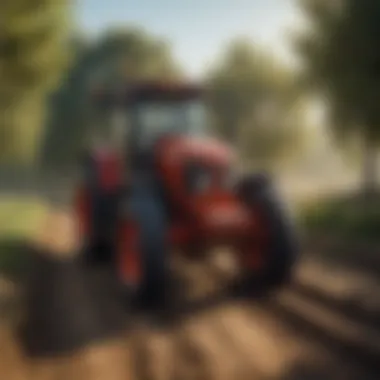
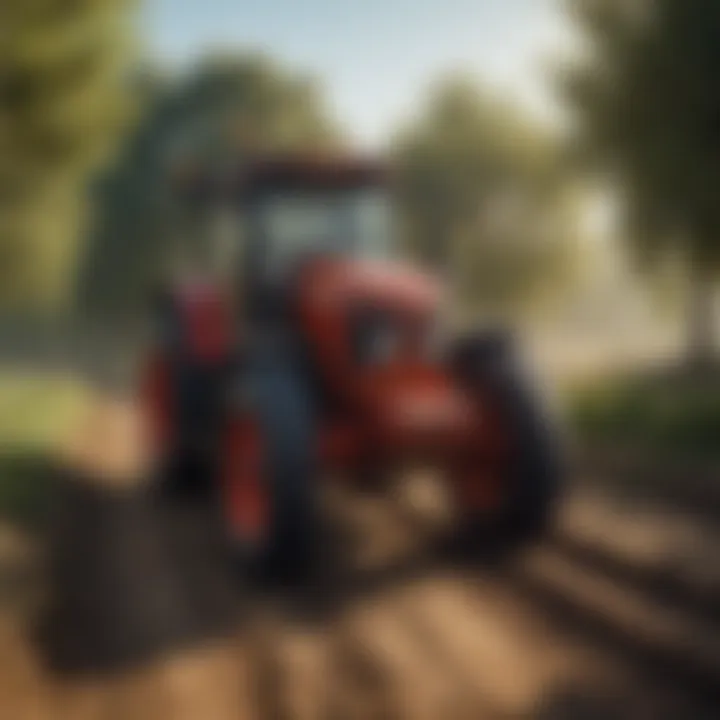
Telematics and Data Analytics
Telematics and data analytics play a vital role in improving tractor performance and overall farm management. By collecting data from various sensors, farmers can monitor machinery performance in real-time, allowing for better decision-making and maintenance.
- Advantages: The insights gained from data can help farmers predict equipment failures, optimize fuel consumption, and even improve crop management strategies based on past performance data.
- Challenges: However, managing and interpreting this data can become overwhelming without the right systems in place, and there can be skepticism among traditional farmers regarding the reliability of such technological tools.
"The synergy of modern tractor technologies not only enhances farming processes but also paves the way for a more sustainable agricultural future."
In summary, the incorporation of advanced technologies like GPS, VRT, autonomous tractors, and telematics into farming practices represents a critical shift in how agriculture is conducted. Not only do they contribute to enhanced efficiency and productivity, but they also enable better environmental management. However, the consideration of costs, training, and data management remains essential as farmers navigate this evolving landscape.
Tractors and Sustainable Agriculture
In today’s fast-paced agricultural world, the connection between tractors and sustainable agriculture is becoming increasingly significant. As farmers aim to produce food efficiently while preserving the environment, the role of tractors evolves to meet these dual objectives. By integrating advanced technologies and sustainable practices, tractors not only enhance productivity but also provide solutions for environmental challenges.
Fuel Efficiency Innovations
Embracing innovations in fuel efficiency is central to the sustainability discourse in farming. Modern tractors are increasingly designed to consume less fuel and reduce emissions. This leap forward often incorporates engines that employ advanced fuel injection systems, precise tuning, and hybrid technologies. For instance, combining diesel engines with electric support not only lowers fuel usage but can also provide farmers a cleaner option overall.
Farmers can take several steps to leverage fuel efficiency innovations:
- Regular Maintenance: Consistent upkeep of tractors ensures they operate at peak efficiency. Simple tasks like checking air filters or ensuring tire pressure can vastly affect performance and fuel consumption.
- Education on New Technologies: Farmers need to remain informed about the latest advancements in tractor technology. Knowledge about options like ethanol blends or biodiesel can contribute to sustainability.
- Investing in Efficient Models: If financially viable, transition to models specifically engineered for fuel efficiency can make a significant long-term impact.
Implementing these innovations not only cultivates a more robust farming operation but addresses the broader implications of fossil fuel reliance, which is critical in maintaining ecological balance.
Soil Conservation Practices
In the realm of sustainable agriculture, soil preservation stands front and center. Tractors, when utilized with the right methods, can significantly aid soil conservation efforts. The following practices emerge as key avenues of integration:
- Reduced Tillage: Modern tractors equipped with tillage systems allow for minimal soil disturbance. This approach helps maintain soil structure and reduces erosion. Farmers using reduced till methods often notice better moisture retention and healthier soil biodiversity.
- Cover Crops and Crop Rotation: Tractors facilitate planting cover crops in off-seasons. This not only prevents erosion but enriches soil organic matter. Rotating crops with tractor-drawn equipment breaks pest cycles and enhances nutrient cycling, promoting long-term soil health.
- Precision Application: Utilizing tractors equipped with precision agriculture technologies allows for targeted application of fertilizers and pesticides. This minimizes runoff and reduces the risk of contaminating nearby ecosystems.
Practices focusing on soil conservation not only foster sustainable agriculture but can yield productive results as well. When approached holistically, integrating tractors into the cycle can lead to legacy farming in harmony with nature, ensuring future generations can reap the bounties of the land.
"Tractors are not just machines; they can be instruments of ecological stewardship."
Implementing these key innovations and practices is essential for farmers today. The blending of technology with mindful agricultural methods serves both economic and environmental goals, establishing a blueprint for future success in sustainable farming.
Economic Impact of Tractors on Farming
Tractors have transformed the landscape of agriculture, acting not just as machinery but as pivotal players in the economic fabric of farming. They are not only essential tools but also a symbol of efficiency and productivity in modern agriculture. By understanding the economic implications of tractors, farmers can make informed decisions that enhance their operational success and sustainability.
Cost-Benefit Analysis
When analyzing the costs associated with tractors, the upfront investment can initially look staggering. Prices vary significantly based on type, size, and technology implementation. For instance, high-performance tractors designed for large-scale operations can reach astronomical figures, while smaller utility models are easier on the pocket. However, the real value of such investments appears when we consider the benefits they impart over time.
- Increased Production: Tractors significantly reduce the time taken for labor-intensive processes such as plowing, seeding, and harvesting. This acceleration in production means farmers can harvest crops more frequently, thereby increasing yield.
- Labor Cost Reduction: Employing tractors minimizes the need for manual labor. The cost savings from fewer hired hands or reduced labor hours can be redirected towards maintenance, technology upgrades, or other essential resources.
- Versatile Applications: Modern tractors are equipped to handle multiple tasks—from tilling soil to transporting goods. This multipurpose capability eliminates the necessity for specialized machines, further streamlining expenses.
“A high-quality tractor could pay for itself in a single season simply by enhancing yield and reducing labor requirements.”
Farmers should approach the cost-benefit analysis with a keen eye on long-term gains, understanding that an initial financial outlay could yield compounding returns through greater productivity and lower operational costs.
Labor Efficiency
The introduction of tractors into the agricultural sphere has revolutionized how work is done in the fields. From traditional farming methods that involved extensive manpower to today's tractor-driven approaches, the evolution is stark. One significant aspect is labor efficiency.
- Speed and Precision: Tractors do not tire the same way humans do. They can operate for extended hours, completing tasks quicker than manual laborers. Furthermore, with advancements like GPS guidance, tasks can be performed with precision that reduces waste and optimizes resource use.
- Workforce Optimization: Rather than employing numerous workers for tillage or harvest, farmers can operate with a lean workforce, relying on tractors to handle the bulk of the work. This shift allows farm owners to focus on oversight and management rather than labor-intensive tasks.
- Skill Development: Tractors necessitate a different set of skills. Farmers and agricultural workers are now trained in equipment operation and maintenance, improving their professional skill set and enhancing overall farm management capabilities.
In summary, the economic impact of tractors on farming is profound, reshaping how farmers approach both their operations and market competitiveness. Investing in tractors is not solely about machinery; it’s about embracing a more efficient and profitable future in agriculture.
Challenges in Tractor Utilization
Understanding the challenges involved in tractor utilization is crucial for farmers and agribusinesses alike. As pivotal as tractors are in modern farming, their operation does not come without difficulties. Maximizing their potential for enhancing productivity requires a thoughtful approach to these challenges, ensuring that the agricultural sector can reap benefits while mitigating risks.
Operational Costs
One of the primary concerns for farmers regarding tractor utilization is operational costs. These costs can add up faster than a rabbit on a date, especially when the machinery operates frequently. Factors contributing to high operational costs include fuel expenses, maintenance fees, and the depreciation of the equipment itself.
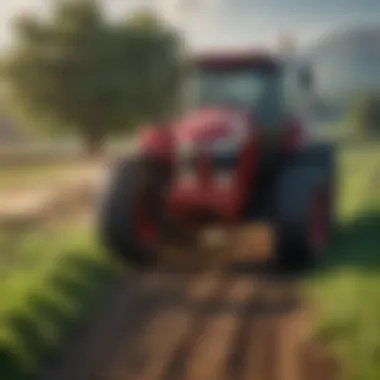

- Fuel Consumption: Tractors consume a significant amount of diesel. With fluctuating fuel prices, keeping costs down requires careful planning and efficiency. The last thing a farmer wants is to break the bank at the pump, just to keep the fields running.
- Insurance and Financing: Owning a tractor often entails high insurance premiums and financing costs. As tractors age, maintenance costs can rise, demanding a keen eye from operators to keep track of budgets.
- Loan Repayments: Many farmers opt for loans to acquire these machines, which can lead to financial strain if crop yields don't meet expectations.
Without a doubt, operational costs play a significant role in how efficiently tractors can be used in the long run. Farmers must strike a balance between productivity and expenses, making informed choices to navigate this challenge.
Dependence on Technology
In today's world, tractors are not just steel behemoths—they are sophisticated machines leveraging technology to optimize performance. However, this dependence on technology brings some double-edged swords.
- Skill Requirements: As technology evolves, so do the skills needed to operate these machines. Farmers must continuously educate themselves on new systems like GPS guidance and telematics. It’s like learning a new language, and some may struggle to keep pace.
- System Failures: Reliance on software and hardware means that when things go wrong, they can go spectacularly wrong. System glitches can halt operations, affecting productivity if not promptly addressed.
- Costs of Upgrades: Staying updated often incurs further expenses. Not all farmers can afford to upgrade their equipment regularly, and this can create a divide in efficiency between larger agribusinesses and smaller farms.
While these advanced technologies offer efficiency and accuracy, farmers must weigh the pros and cons.
Maintenance Requirements
Like any machine, tractors require regular maintenance to function optimally. Proper upkeep is an essential aspect that cannot be ignored. In the long run, neglecting maintenance can lead to severe issues that could have been avoided.
- Routine Checks: Regular inspections for fluid levels, tire conditions, and other mechanical aspects are crucial. Not checking these can lead to catastrophic failures—akin to driving with a flat tire.
- Expert Skills Needed: Proper maintenance isn't always straightforward. A farmer might not always have the expertise or time needed to ensure tractors are in tip-top shape. This may necessitate extra hiring, which further increases costs.
- Parts and Labor Costs: Over time, parts will wear down and require replacement. The associated costs can be staggering, not to mention the time lost if a tractor is out of commission during peak harvesting seasons.
In summary, understanding these maintenance requirements is vital to prevent mishaps that could hinder agricultural operations.
"Efficient tractor utilization is about outsmarting the challenges—prior planning keeps the wheels turning smoothly."
Navigating the difficulties associated with tractors demands a strategic mindset. By addressing operational costs, managing reliance on technology, and rigorously maintaining equipment, farmers can not only sustain but also enhance their agricultural practices.
The Future of Tractors in Agriculture
As we look to the future, the role of tractors in agriculture is poised for transformation. With an ever-growing population and increasing demand for food production, it's pivotal to explore modern adaptations and innovations that tractors can contribute. This section probes into how tractors are evolving to meet the challenges of sustainable agriculture, efficiency, and resilience in the face of climate change.
Emerging Technologies
Electric and Hybrid Tractors
Electric and hybrid tractors are making waves in agricultural machinery, heralding a new era in farming. One of the main aspects of these tractors is their potential to significantly reduce greenhouse gas emissions. Farmers are increasingly drawn to these cleaner alternatives, as they not only boost sustainability but also lower fuel costs. A key characteristic of electric tractors is their quiet operation, which leads to less noise pollution—an often-overlooked benefit in rural areas.
Notably, a unique feature of many hybrid models is the dual power system. Farmers can switch between electric and diesel power depending on operational needs, giving flexibility. However, disadvantages include a higher initial purchase price and the need for adequate charging infrastructure, which may not yet be widely available in some farming regions.
Integration with Drones
The integration of drones into farming practices is becoming another innovative facet of modern agriculture. This technology plays a crucial role in enhancing efficiency. Drones can facilitate crop monitoring and data collection, providing farmers with real-time insights into crop health, soil condition, and even pest infestations.
A major advantage of incorporating drones is the ability to cover large areas quickly, which is lifesaving during harvest season or when assessing crop damage. However, farmers must consider the unique features of these systems, such as the need for training to operate drone technology effectively and potential regulatory hurdles for airspace utilization. Still, the benefit of combining drones with tractors can lead to more informed decision-making and greater precision in resource application, having a profound impact on productivity and sustainability.
Tractors in Climate-Resilient Agriculture
In the face of climate change, tractors designed for climate-resilient agriculture are gaining importance. These tractors are built to handle varying environmental conditions, from droughts to floods, ensuring that farmers can maintain operations despite unpredictable weather.
Resilience is served through adaptive technologies such as advanced GPS systems that aid in precision planting, or soil sensors that provide data on moisture levels, allowing farmers to make informed irrigation choices. These methods can help optimize water use and improve soil health, ultimately contributing to sustainability.
"The adaptability of tractors to meet both current and future farming challenges reflects a significant shift in agricultural practices."
As the industry continues to embrace these technologies, the future of tractors will rest on their ability to merge efficiency with ecological sensitivity, ensuring they support farmers in the quest for productivity in a challenging climate.
Culmination
As we wrap up this exploration into the pivotal role of tractors in modern agriculture, it is essential to emphasize the monumental impact this machinery has had on the farming landscape. Tractors are more than mere tools; they are the backbone of agricultural productivity, enabling farmers to transform their practices and yield efficiencies that were once thought impossible.
Reflecting on the Impact
One cannot overlook the sheer transformation that tractors have brought about in farming methods. The introduction of tractors equipped with advanced technologies has led to drastic reductions in labor costs while optimizing tasks such as plowing, seeding, and harvesting.
- Enhanced Productivity: Farmers can now accomplish more in fewer hours, which directly translates to better outputs and greater profits.
- Accessibility to Larger Areas: Modern tractors allow farmers to manage larger fields with ease, making it financially viable to farm previously underutilized lands.
- Efficiency in Resource Use: With features like GPS guidance systems and variable rate technology, the precision of resource application has improved, prompting sustainable practices that align with environmental health considerations.
However, while it’s clear that the positive impact of tractors cannot be understated, it’s also important to address the challenges that accompany this technology. The reliance on machinery necessitates a deeper understanding of maintenance requirements and operational costs.
Looking Ahead
Looking into the future, the role of tractors will continue to evolve. Emerging technologies such as electric and hybrid tractors, as well as their integration with drones, signal a shift toward an even more sustainable and efficient agricultural framework.
- Electric and Hybrid Tractors: These innovations offer reduced emissions and operational costs, aligning with global sustainability goals. The environmental benefits are significant in the long run, as they contribute to a lesser carbon footprint.
- Integration with Drones: Using drones in conjunction with tractors can provide real-time data on crop health and field conditions, allowing for timely interventions and optimized resource use.
As farming practices adapt to face challenges like climate change, tractors that emphasize versatility, efficiency, and sustainability will be key players in the ongoing evolution of agriculture. The industry must remain vigilant, embracing innovations while also being cognizant of the potential pitfalls that complex machinery presents.



